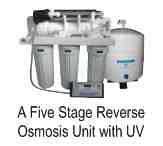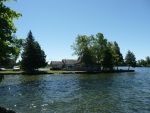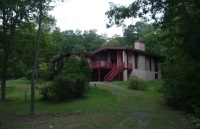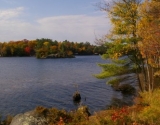Reverse Osmosis Water System
This is the finest filtration available today. It is the treatment typically used by premium bottled water companies.
A very wide array of contaminants are eliminated or substantially reduced.
Reverse osmosis water systems filter particles through a membrane which is approximately 0.0005 micron in size (bacteria are 0.2 to 1 micron & viruses are 0.02 to 0.4 microns).

These systems also successfully treat water with dissolved minerals and metals such as aluminum, arsenic, barium, cadmium, chloride, chromium, copper, fluoride, magnesium, iron, lead, manganese, mercury, nitrate, selenium, silver, sulphate, and zinc.
It is also removes many taste, color, odour-producing chemicals, particulates, total dissolved solids, turbidity, and radium. There are two types of Reverse Osmosis Water System membranes typically used in home or cottage water purification systems:
TFC membranes will filter out considerably more contaminants than a CTA membrane however, they are more susceptible to degradation by chlorine.

A typical RO system is composed of first, activated carbon (GAC) pre-filters, the RO membrane, a storage tank, and a faucet to deliver the purified water to your counter top.
Please note that RO systems vary in membrane quality, output capacity, and storage capacity.
The effectiveness of a system depends on the quality of its components - especially its pre-filter cartridges and the membrane itself.
Lower quality pre-filters will suffer from premature membrane fouling, reduced performance, lower purified water output, and a shorter membrane life.
How does Reverse Osmosis Work?
A Reverse Osmosis Water System uses a membrane, or simply a filter, allowing pure water to pass through it.The membrane should continually clean itself.
The rejected contaminants are swept away from the membrane and down the drain. Contaminants are rejected as they are too large to pass through the tiny pores in the membrane.
Applications for This System
For almost all home or cottage water purification, reverse osmosis is an excellent choice. It is the most recommended solution for a pre-treated municipal water system.For lake source water that may contain biological contaminants consider a whole house ultraviolet system or a combined reverse osmosis and ultraviolet system for maximum protection.
For the cottage a sediment pre-filter system with activated carbon pre-filter and/or post filter should be installed also. This will enhance you system and will ensure the efficiency of the UV also.
In Summary: Reverse Osmosis is capable of rejecting bacteria, salts, sugars, proteins, particles, dyes, heavy metals, chlorine and related by-products.
*For cottage country it is recommended that you also use UV purification.

The actual amount of water produced in your cottage will depend on the water pressure and system installed.
RO water purification occurs slowly through a fine filter. A small storage tank can be used to hold 3 gallons of purified water. Larger systems can be installed also.
Cottages for Sale- Home

BIG RIDEAU LAKE
3276 MacDonald Island Road

1473 North Shore Road Kingston


BUYER PROGRAM
